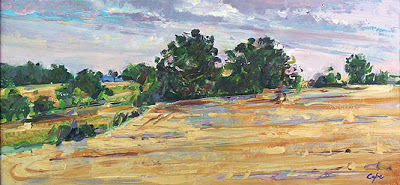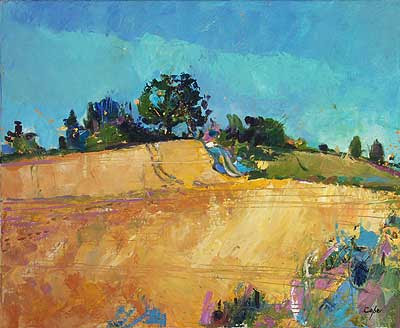Constable’s ‘Cornfield’
While now a fresher gale, sweeping with shadowy gust the fields of corn –
Text used by John Constable in exhibition catalogue, for his ‘The Cornfield’ in The National Gallery, London
John Constable, “The Cornfield”, painted 1826. Size: 56 by 48 inches (143 by 122 cm).
National Gallery, London (UK).
It was a friend of mine that remarked on the similarity of my painting above to Constable’s famous painting. Constable’s ‘Cornfield’ is so well known & such an English national icon, that it’s become something of a cliché, and so is difficult to see and admire without a strong feeling of going backwards in time…
Of Chocolate Box Paintings?
…. to an England & a countryside that no longer exists, other than on lids of chocolate boxes…. though sometimes you can still find snippets & glimpses of Constable’s subject matter, feeling abit like Keat’s nightingale song, briefly present for a moment only…. Is this what we mean when we say a landscape is “unspoilt”? That it resembles a pastoral painting?…. An expression of painful yearning for a lost arcadia, an unreal place that never was?… I remember going to the National Gallery to admire this painting with my Granny around the impressionable age of twelve. I guess I’m the type of expat Englishman who was taught to be skeptical of nationalist feelings, to love gardens… and to like chocolates! ….
The English countryside has changed greatly since 1826, as has the French countryside here in the Dordogne, the principal change being ‘remembrement’ (literally ‘dismemberment’), the reorganisation of smaller fields into larger fields, which involves the grubbing out of hedgerows and any tree-lined path, such the one that leads us into Constable’s painting. Other changes are the use of pesticides & modern seed grain, which give the beautiful expanses of (mono-culture) wheat, which to my eye, still remain an incredibly beautiful sight.
It was partly because the association with such a nostaligic & traditional (outdated?) icon that the next day I painted the same type of subject mattter ‘à la contemporaine’ ,
Blé & Chene (fr) = wheat & oak (en)
© The Artist
Fields of colour, not quite colour field painting.
Each year ‘en plein-air’ , following the yearly crop cycles, still asking some of the same questions, still paint…here’s another painting, from ten years ago, of corn & the ‘vibrating emptiness’ of huge fields of mono-culture, sun, summer & colour. Fields of colour, not quite colour field painting.
No space for nature in the countryside?
What I still hold to be of great interest in Constable’s work, other than his love for nature & weather & plein-air, is his intense interest & knowledge of the countryside & it’s economy. The rural economy here in the Dordogne remains principally agriculture but… in certain areas, tourism has now the principal economic activity. This can lead to a clash of ideas & financial interests of what & how the countryside should look like. And if there should be any space for nature in the countryside… hedgerows with trees, nightingales & wildflowers or remembrement? (literally the cutting off of members…the grubbing out of hedgerows to make larger fields).
Must everything be destroyed by a mechanical, pesticided, subsided agriculture? Isn’t nature part of the countryside? Aren’t we part of nature? The trees and the other parts of the eco-system, what about them? Don’t they too have the right to be part of the countryside?
It breaks my heart & makes me despair.
[button color=”green” size=”medium” align=”center” link=”https://www.artists-atelier.com//category/blog/artists-and-ecology/”]Artists & Ecology[/button]
Read more artists & ecology in this blog:
Artists & Ecology #1 – Festival Flore Faune
Artists and Ecology #2 – Robert HAINARD – how to ‘blind contour draw’ Artists & Ecology #3 – Constable, Corn & the Destruction of Hedgerows Artists & Ecology # 4 – Paintings of Potatoes, Semances & Homage à José Bové Artists & Ecology # 5 -Le Dropt, Castillonnés , a green corridor? Artists & Ecology # 6 – No Space for Nature in the Countryside? Wendell Berry




